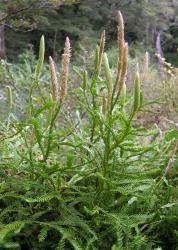- = Diphasium C.Presl ex Rothm., Feddes Repert. Spec. Nov. Regni Veg. 54: 64 (1944)
- = Pseudodiphasium Holub, Folia Geobot. Phytotax. 18: 440 (1983)
- = Pseudolycopodium Holub, Folia Geobot. Phytotax. 18: 441 (1983)
- = Austrolycopodium Holub, Folia Geobot. Phytotax. 26: 90 (1991)
Terrestrial, scrambling or climbing plants. Main stems indeterminate, horizontal and either subterranean, creeping, or climbing, giving rise to determinate, erect or inclined, branched aerial stems, often of different thickness to the horizontal stems. Roots arising at intervals along the length of horizontal stems. Leaves either similar and spirally arranged, or of two or three kinds and arranged in ranks (anisophyllous); leaf margins entire or minutely ciliate. Bulbils absent. Sporophylls modified and aggregated into distinct strobili, ephemeral. Strobili terminal on ultimate branches, erect or pendent, sessile or stalked. Spores reticulate or baculate (NZ) or scabrate (not NZ).
A genus of c. 58 species (PPG 1 2016, including all species in the subfamily Lycopodioideae).
Following Øllgaard (1987, 1989, 1990) the lycopodioid clade within Lycopodiaceae is interpreted here to include just two genera, Lycopodiella and Lycopodium. However, more recent classifications further subdivide these taxa into four and nine genera, respectively (Field et al. 2016).
The lycopodioid clade is distinguished by anisotomous branching, with dichotomies resulting in branches of unequal thickness; horizontal, indeterminate main stems that are creeping, looping or climbing, and give rise to aerial determinate branches; roots that arise at intervals along the length of the main stem; strongly modified sporophylls aggregated into strobili (Øllgaard 1987, 1990); and reticulate, baculate or rugulate spores (Tryon & Lugardon 1991, figs 229.1–12, 230.1–12; Large & Braggins 1991).
Lycopodium is distinguished from Lycopodiella by its horizontal and subterranean, scrambling or climbing stems. Strobili are either erect and sessile or stalked, or pendent and in clusters. Spores are reticulate or baculate (Tryon & Lugardon 1991, figs 229.1–12; Large & Braggins 1991). In New Zealand, some species have sterile leaves flattened in one plane, of two different sizes.
Four species of Lycopodium (as circumscribed here) are present in New Zealand. In the classification of Field et al. (2016) they would be placed in four different genera: L. deuterodensum in Pseudolycopodium, L. fastigiatum in Austrolycopodium, L. scariosum in Diphasium, and L. volubile in Pseudodiphasium.
| 1 | Sterile leaves of distal branches flattened in one plane, of two or three markedly different sizes | 2 |
| Sterile leaves of ultimate branches spirally arranged around stem, all about the same size | 3 | |
| 2 | Smaller leaves in two rows on dorsal surface and one row on ventral surface; strobili borne on separate fertile branches in pendulous clusters | volubile |
| Two or three rows of smaller leaves on ventral surface only; strobili erect and solitary on short-leaved stalks, terminal on aerial stems | scariosum | |
| 3 | Aerial stems 150–1900 mm long; sterile leaves on mature aerial stems tightly appressed; strobili sessile | deuterodensum |
| Aerial stems 40–520 mm long; sterile leaves incurved but never appressed; strobili borne on sparsely leaved stalks, 5–60 mm long | fastigiatum |
A genus of over 50 species, mostly occurring in north and south temperate regions or in alpine areas of the tropics; eight species in southern Africa (Roux 2009), four in Australia (Chinnock 1998). Four indigenous, non-endemic species in New Zealand.
| Category | Number |
|---|---|
| Indigenous (Non-endemic) | 4 |
| Total | 4 |
Chromosome numbers in Lycopodium are very variable. In sect. Lycopodium (= Lycopodium s. str.), sect. Annotina (= Spinulum), sect. Obscura (= Diphasiastrum) and sect. Lycopodiastrum (= Lycopodiastrum) the base number is n = 34; in sect. Complanata (= Diphasiastrum) n = 23; in sect. Diphasium (= Diphasium) n = 34–36, and n = c. 90; and in sect. Magellanica (= Austrolycopodium) n = 31; (Øllgaard 1987, 1990).




